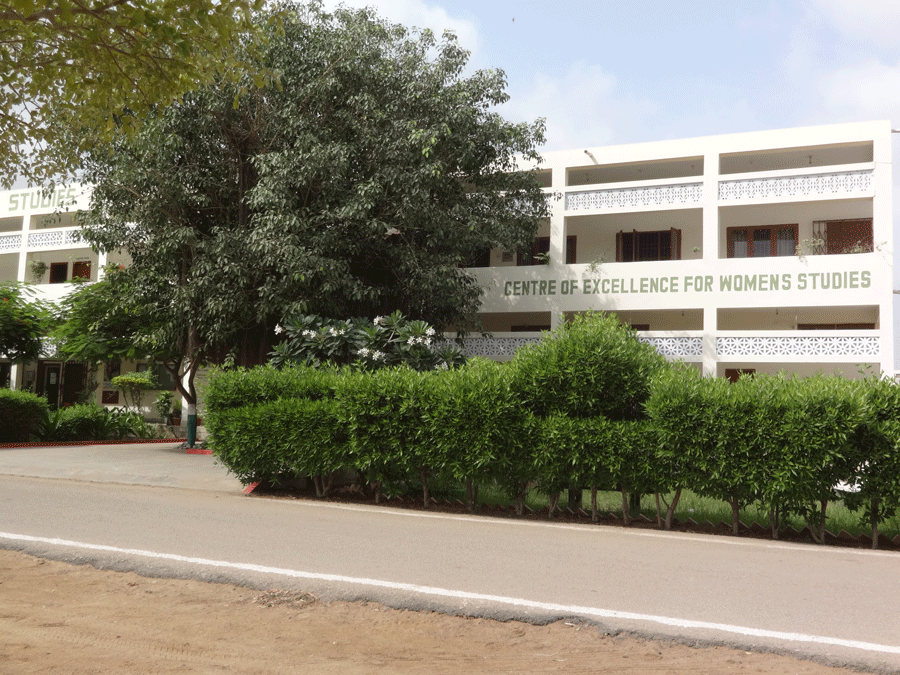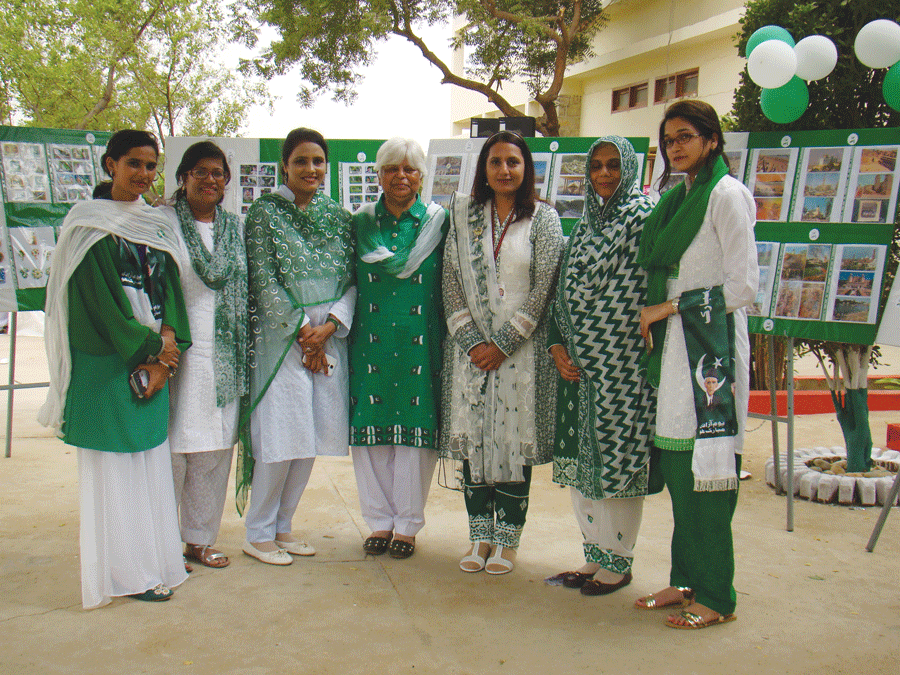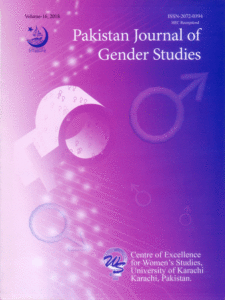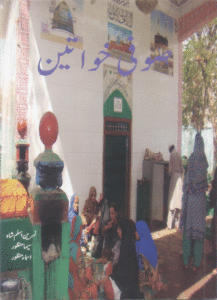The Invisible Half
By Deneb Sumbul | Education | Published 7 years ago
I’m not afraid of storms, for I’m learning how to sail my ship.
— Mary Louise Alcott, Author of Little Women series.

CEWS, Karachi University: The hub of gender specialists.
These words ring true of the women – and men – teaching and studying at the Centre of Excellence for Women’s Studies (CEWS) located at the Karachi University Campus. The department offers a treasure trove of in-depth studies and reports that are invariably women-centric. It is a repository of researches that are conducted by students with a particular interest in gender studies.
True to its objective of promoting and facilitating educational opportunities and capacity-building for women in various fields, the CEWS – also known as the Women’s Studies Department – has produced an impressive team of gender experts, many of whom are employed in assorted fields. Says its present director, Dr. Nasreen Alam Shah, “I am very proud of the fact that students graduating from the Women Studies Department are getting better jobs compared to those of other social science departments at the Karachi University.”
The professors at the CEWS oversee Honours, Masters, Ph.D and M.Phil students working on assorted theses concerning a plethora of problems faced by women and children. These works also provide crucial insights into the society at large. However, a majority of these qualitative and quantitative studies pertain to Karachi and its periphery, and some of them have taken as long as five years to complete.
Since its inception in 1989 as a project of the Ministry of Women’s Development, Government of Pakistan, CEWS graduates have been employed by numerous local as well as international non-profits involved in research, planning and development such as the Social Policy Development Centre (SPDC), the Aga Khan Rural Support Programme (AKRSP), the World Wildlife Fund (WWF), Aurat Foundation, Shirkat Gah, War Against Rape (WAR), Health-Oriented Preventive Education (HOPE), Madadgar, Pakistan Institution of Labour Education and Research (PILER), Labour Education Foundation (LEF), Society for the Protection of the Rights of the Child (SPARC), Society for the Advancement of Community Health, Education and Training (SACHET), Inter-Press Communication (IPC), and Rozan. Several CEWS graduates have found administrative positions and are also employed in government departments such as the Ministry of Women and Development (MoWD), Women and Development Department (WDD) Sindh, and in universities across the country such as Sindh University (Jamshoro). Professor Dr. Tahira Aftab, the first director of the Women’s Studies Department, played a key role in setting it up in 1989.
In 2003 Dr. Nasreen Aslam Shah, the present CEWS Director and meritorious professor, took charge from its former director, Professor Dr. Khalida Ghous, who is presently the managing director of the Social Policy and Development Centre (SPDC) – one of the leading non-profit research think-tanks in Pakistan.
Dr Shah has also served as the Chairperson of its twin facility, the Department of Social Work, where she joined as a lecturer in 1988. She received her own M. Phil degree in 1993 for her comparative study on loans taken by women from a governmental organisation (First Women’s Bank) and an NGO (Orangi Pilot Project). Her thesis, Self-employed women of katchi abadis: Investigation for typology formulation and determination of economic contribution in urban informal sector examined to what extent women managed to improve their small businesses as a result of these loans. Dr Shah also acquired a Ph.D degree on her thesis, Changing role of women in Pakistan: A study of social and economic activities of women entrepreneurs (2002).
As a teacher, research advisor and field supervisor to graduate and post-graduate students for over 30 years, Dr Shah has overseen 110 Masters theses at the Department of Social Work and 130 at the CEWS. As an accredited Higher Education Commission (HEC) Ph.D supervisor, she has also supervised over two dozen Ph.D and M. Phil students on their researches, several of whom have been awarded their degrees. She has also authored as well as co-authored assorted CEWS and Karachi University books and publications, reviewed books by Oxford University Press and is associated with, or on the editorial board of several journals.
When asked about the changes that have taken place in CEWS since she became its director, Dr Shah said, “It has always been about teamwork. When I took charge, the Women’s Studies Department comprised only three rooms, with barely 10 to 15 students. Presently, we have between 300 to 350 students studying at the Honours degree level to Ph.Ds, and they populate an entire building block dedicated to Women’s Studies. The ratio of boys to girls studying here is 10 per cent boys and 90 per cent girls, whereas the overall trend in the rest of Karachi University is 25:75.”
Although the maximum capacity of students is 50 per batch, the number of students presently joining Women’s Studies first year Honours has risen to 120 a year in the past three years. However, these numbers tend to drop by the time of graduation, because of marital commitments or for economic reasons. An average of 80 students per batch follow through to the Masters level. This figure, however, fluctuates every year. Urdu is the medium of instruction but the students are permitted to pursue their studies in English if they so desire.

CEWS Strength: Left to Right – Prof. Dr. Nasreen Aslam Shah, Seema Manzoor, Dr. Asma Manzoor and Shazia Sharafat.
Although CEWS’s research universe is limited to Karachi and its periphery, it is not without problems and delays, especially for the female students. Karachi’s volatile nature hampers their academic research, which requires them to meet thousands of women, children and family members. Street crimes, general lack of security for women, strikes and city shutdowns, unannounced holidays and forced closures of educational institutions are some of the factors that impede them.
Often parents/guardians refuse to allow female students to travel for their research, even within the city. Some are not even permitted to visit other libraries, offices or organisations. And those who do, look for a fellow student or two to accompany them on their research trips. Moreover, most students are in a hurry to get back home lest their parents panic.
Nonetheless, most CEWS students have managed to overcome these hurdles and produced substantive work, and hundreds of students of all ages and both sexes have managed to acquire their university degrees in Women’s Studies. The second edition of the CEWS publication, Bridging the Gap, published this year, is a selection of the Master theses completed between 1997 to 2009 at the MA and Ph.D level. The book also includes research commissioned on women-related topics by various forums. The Pakistan Journal of Gender Studies is another publication CEWS has been producing annually since 2008, this year being its 16th volume, and it includes theses of Ph.D students from universities across Pakistan.
Dr. Asma Mansoor, currently Assistant Professor at the Women Studies Department, explains: “The greatest positive outcome has been the employment ratio of students graduating from CEWS. Around 60 to 70 per cent of the women find employment, while the boys, 100 per cent. Also, students often find employment on the basis of their third-year internships and the fieldwork they conduct for their mandatory thesis.
She further explains, “Many of our graduates are currently working for well known institutions and NGOs, such as Hands and the National Commission on the Status of Women (NCSW). Some have teaching positions at JPMC and Punjab University, while other students are employed in the media, banks and airline companies, where gender sensitisation is being incorporated. Previously companies would employ psychologists, but now they are hiring gender specialists in human resources departments because of their specialisation.”
Women working in Export Processing Zones
The subject of Dr. Asma’s research for a Ph.D degree from CEWS was the women working in Karachi’s export processing zones, where very little access is given to outsiders. Her published Ph.D thesis, A Study of Socio-Economic Conditions for the Establishment of Export Processing Zones and Reasons of Employment Attraction for Women in the Karachi Export Processing Zone (2013), explores the socio-economic conditions that led to the formation of Karachi Export Processing Zones (EPZ) in Pakistan and the reasons why it held an attraction for women.
As the country’s industrial and economic hub, Karachi has always attracted an increasing number of job-seekers. EPZs are an integral part of the expanding global market, and an easy-to-control labour force is a prerequisite in a market economy. Dr. Asma’s study examined the consequences of establishing EPZs, and the resulting in-flow of foreign investment in Pakistan. The incentives given to them through government policies had caused further disparities and disadvantages among the labour class.
Through interviews of 330 women working in 25 industrial units of varying production capacity that she conducted, Dr. Asma found that instead of empowering women through employment, EPZs facilitated their exploitation.
Although her findings were not dramatically different from similar studies conducted in other countries, one major difference she found in Pakistan was the presence of a strong family unit. The women workers she interviewed would sound happy and relaxed when they spoke of returning home to their families after finishing their factory jobs. However, her findings revealed that as tools of poverty alleviation, EPZs and foreign investment did not show a high rate of success.
Women Prisoners of Karachi Central Jail
One of the very interesting studies conducted under Dr. Shah’s tutelage was by Assistant Professor, Dr. Aliyah Ali Bilgrami, on women prisoners at the Karachi Central Jail. She interviewed some 200 female jail inmates for her thesis, Causes of crimes among female prisoners in Karachi Jail: A study of the socio-economic and environmental problems and effects on personality (2010). To gauge their physical and mental health, she selected female prisoners from the Youth Offenders Industrial School and Special Prison for Women for her survey.
These women had been imprisoned for crimes of murder, drug-smuggling, child-kidnapping, theft, etc. More often than not, their offences were a consequence of poor economic conditions and illiteracy. However, there were cases of highly educated women prisoners as well. Dr. Aliyah shares, “I met many highly educated women in jail. One of them was accused of her husband’s murder and she had a Masters Degree in English and had been teaching at the PAF Academy. Another was a graduate and was teaching prisoners in the jail.”
Dr. Aliyah’s findings revealed that the female inmates suffered immensely in police custody, as well as in jail. More than 60 per cent of the women prisoners were married, and/or were mothers of either minors or teenagers. Those imprisoned along with their children, suffered more than others, from psychological issues. Dr. Aliyah shared how one of the inmates said that once she was released from prison, she intended to return to her previous line of work – smuggling – because she had no other skills and it was good, easy money.

Trade Bodies Assistance to Women Entrepreneurs
Shazia Sharafat, a visiting faculty member at CEWS, submitted a Ph.D dissertation in 2017 titled, An Analytical Study of Trade Bodies’ Assistance to Growth of Women Entrepreneurs, that gave interesting insights on the businesswomen of Karachi.
Shazia ’s main objective was to evaluate the assistance and platforms provided to women entrepreneurs by the various business associations and the Chambers of Commerce and Industry that helped them expand their businesses. Her research also highlighted the lack of data on the number of women entrepreneurs in the country.
Shazia interviewed 200 businesswomen from five major business associations: the Federation of Pakistan Chambers of Commerce and Industry (FPCCI), Karachi Chambers of Commerce and Industry (KCCI), the Pakistan Software House Association (P@SHA), the Sindh Industrial Trading Estates (SITE) and the Korangi Association for Trade and Industry (KATI).
These women entrepreneurs were involved in a range of businesses including textiles, handicrafts, furniture, medicine, and import and export. A majority of these 200 women were involved in Small Medium Enterprises (SMEs) and as independent businesswomen, they had invested in their own enterprises and had decision-making powers on all aspects of their businesses.
Sharafat’s research found that in collaboration with the Trade Development Authority of Pakistan (TDAP), these trade associations extended women entrepreneurs opportunities to participate in international exhibitions, even providing them subsidised rates for stalls and accommodation; helped groom them in marketing techniques and assisted in fine-tuning their businesses so that they could run their enterprises better, independently. She also found these trade bodies frequently provided training programmes and consultations in collaboration with the Small and Medium Enterprises Development Authority (SMEDA) on how to best exhibit products in local and international EXPOs and assisted them in packaging and establishing price points for their products.
The businesswomen found themselves in a much better position after joining these assorted business associations, as compared to those female entrepreneurs who were not members. Shazia’s study strongly recommended that the private business sector have an outreach for the numerous other deserving businesswomen, who could derive similar benefits from joining these trade bodies.
Sufi Women of Karachi and Thatta
 One of the most interesting published studies I came across at the CEWS office was titled Sufi Khawateen (Sufi Women), based on a research conducted on the tombs of Sufi women in Karachi and Thatta by Dr. Nasreen Aslam Shah, Dr. Asma Manzoor and her younger sister, Seema Manzoor .
One of the most interesting published studies I came across at the CEWS office was titled Sufi Khawateen (Sufi Women), based on a research conducted on the tombs of Sufi women in Karachi and Thatta by Dr. Nasreen Aslam Shah, Dr. Asma Manzoor and her younger sister, Seema Manzoor .
When asked how they came to select the unusual topic of female Sufi saints, Seema Mansoor, who is a lecturer and has submitted her Ph.D dissertatio, replied, “Since we focus on women’s issues and their visibility in gender studies, we use a basic term called ‘missing women.’ Our main motivation is the acknowledgement of women’s participation in society, which is rare.”
“The same goes for women in the religion paradigm. The contributions and teachings of women in Sufi Islam are not accorded the same recognition or value as the male Aulia, because of the existence of strong patriarchal norms. Since women in our social structures are regarded as inferior and the male, superior, it’s a perspective shared in Sufism as well. There is an unwillingness to recognise women as Sufis and it stems from men’s fear of losing their hold on society. Men tend to exercise control by manipulating religion; women are discouraged from any public interaction because it means they would wield a greater influence, and the more their influence in society, the greater their following and the stronger their hold.
“These women had an Islamic education, so they were literate in religious terms. Some served their community by helping the poor and the needy. After their demise, their graves were turned into shrines by followers and they began to be called Sufis – at least that is how some of these shrines evolved. Nonetheless, most contributed and played a role in the societies they lived in, making women aware of their rights in Islam in the course of their preaching,” says Seema.
Sufi Khawateen catalogues the findings on 18 such tombs in Karachi and eight in Thatta. This book also discusses the various schools of thoughts in Sufi Islam, which ones these Sufi women belonged to, the present state of their shrines, the differences and similarities in their beliefs, their economic background, the level of education of the followers of these female saints and the various rituals of the visitors to their shrines. The visitors to these shrines in Karachi and Thatta are mostly women who seek good health, economic well-being or a child – the usual things that people pray for at the shrines of male Sufis.
However, the tombs in Karachi are well maintained because they are either located within the community, which looks after them, or by the followers of the silsila (school of thought) the female Sufi is associated with. The shrines of the female saints in Thatta are in a dilapidated state and issues of cleanliness and hygiene abound. Researchers maintain that there are between 70 to 80 known shrines of Sufi women in Karachi alone. A street called Mazar Galli in old Karachi has shrines of nine women saints.
Dr Shah plans to extend their research to the shrines of those Sufi women they have not yet covered in Karachi, and further to extend their research beyond Makli and Hyderabad, possibly up to Multan.
The Higher Education Commission (HEC) extends considerable support to CEWS and has commissioned several studies, including The Role of Women Councillors in the Local Government System and its Impact on the Political Status of Women in Pakistan; Women’s Experience of Religious and Social Traditions: Gender, Religious Authority and Devotional Islam and Girl Child: Issues and Challenges (data on girl beggars of Karachi). Other organisations such as UNICEF, USAID, Women’s Ministry and the KU have also commissioned studies and projects.
Although assorted forums have utilised and commissioned CEWS for research, it is not nearly enough. Both within and outside Pakistan, the media, government representatives and donor agencies still maintain that not enough research exists on women’s issues in Pakistan.
But even so, the good news is that there are over 60 research studies published by the Centre of Excellence for Women’s Studies which would be of great interest to students, researchers, writers, and invaluable to dedicated change-makers, movers and shakers, and law and policy-makers for formulating further projects, programmes and policies.
The writer is working with the Newsline as Assistant Editor, she is a documentary filmmaker and activist.


